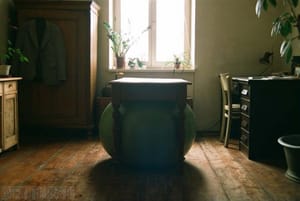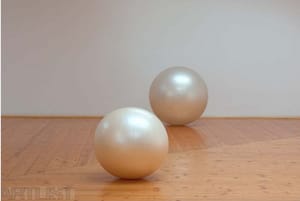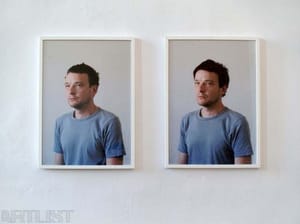- First Name
- Jan
- Surname
- Haubelt
- Born
- 1977
- Birth place
- Prague
- Place of work
- Prague
- Website
- www.ladviweb.ic.cz
- Keywords
- CSU Library
- ↳ Find in the catalogue
About artist
Impractical Mood, which Jan Haubelt exhibited in July 2010 at the Vedro exhibition at Meetfactory, contains and comments in concentrated form on many of the commonest motifs in the work of this artist. Illusion is central to this work and operates on many levels. Three sets of diapositives alternate in the projection – one comprises documentation of various forms of illusory images, such as stage sets, models, museum reconstructions or diorama; the next is a series of well known optical illusions (e.g. segments of the same length which appear to be of various lengths, etc.), which we can read as a key unlocking the artist’s approach; finally there is a set of genuine perceptual illusions – several pieces of coloured paper were repeatedly folded and documented in photography, which resulted in a strange verismo depiction of a three-dimensional space, in which the illusion is not quite right and disintegrates from within.
Combined work with the material and perceptual aspects of the artefact, its spatial situation and two-dimensional photographic output is characteristic for Haubelt. Jan Haubelt studied at the Kurt Gebauer Sculpture Studio at the Academy of Arts, Architecture and Design, Prague. He was also interested in moving forms of art. In his photographs from 2006, in which he himself appears in strange positions, we also see statues and pantomimic moments. These are static realisations in space, whose expressiveness is attained inter alia by means of precise work with the plasticity of the artist’s own body. However, the illusory image of the unlikely position of the body works only in photography. The result is a realistic documentation (ensuing from the character of photography itself) of the impossible.
An interesting basis for considerations of the status of changes to the world as a consequence of human activities is offered by Haubelt’s work with the “invisible” metamorphosis of ordinariness, in which the imitation of a piece of reality is reintroduced into reality. Transplanted Stump (2006) remains, despite the demanding nature of the intervention, what it is – a tree stump in a park which is unrecognisable as a work of art. People use wigs in order to look like someone else. However, when the wig itself is made out of the hair of the person wearing it and cut into their usual style, this clearly is not the case (Without, With, 2007). Attaining a realistic imitation of pigeons in a place where real pigeons gather only draws provokes attention by virtue of the fact that the birds are not moving (Pigeons, 2008).
Haubelt’s examination of the possibilities and limits of vision becomes more and more complicated. Photography is not used only as a misleading testimony about reality, but is thematicised in this very role. In connection with the exhibition Last But Not Least at the Školská Gallery (2009) we might recollect Descartes’ illustration (from the Meditations on First Philosophy) of the deceptiveness of judgements which we reach on the basis of sense perceptions: I look out of the window to the street below, where people are walking in hats – however, in reality I don’t see the people, but only their hats, and the fact that people are beneath these hats is not at all clear. Haubelt first used the gallery as a “studio”, where he photographically documented objects in various spatial situations, and then exhibited both the photography and the objects featured in it in the gallery. The confrontation with the copy allows him to disclose the sham of the photographic perspective: in a photograph we ascribe the difference in the size of two spheres to foreshortened perspective. Soon, however, we realise that they are genuinely of different sizes. We see only one chair in a photograph, though there are two chairs, one behind the other. And so on.
As well as “jokes” involving invisible interventions Haubelt is also interested in the aesthetic and atmospheric possibilities of such subtle shifts when modifying the organisation of real items. Various configurations of items attain a specific result depending on their situation, as though their location in a certain space activated a slumbering ability to induce a mood. Photography is shown as a privileged method by which to fix these configurations of items in their place. Haubelt’s realisations in specific environments, which includes the series Things From This Place (2008–2009), is reminiscent of the “constructed situation” favoured by the situationists, i.e. places for the “play of poetic subjects amongst poetic objects”. However, this game is genuinely private and non-transferrable, it is accessible only as mediated in the form of a photographic record, which lends the entire scene a certain melancholy.
- Author of the annotation
- Václav Magid
CV
Studies:
2001-2007 Academy of applied arts, architecture and design, Prague
sculpture studio of Kurt Gebauer
1992-1996 dentist school
Stipends:
2006 Academy of Fine Arts, studio of monumental art, Jiří Příhoda
2005 Athens School of Fine Arts, Greece
Employment:
since 2005 Founding member of the Ládví group
- Member of art groups included in ARTLIST.
Exhibitions
- Solo exhibitions
-
2012
Jan Haubelt: Slepá díra / Blind Hole, Karlin Studios, Praha
2011
Jan Haubelt: Pravým jménem, Galerie 35m2, Praha
2010
Negativní thonet, Pražákův palác / prostor pro jedno dílo, MG Brno
2009
V neposlední řadě, Galerie Školská, Praha
Horem dolů, Galerie Pavilon, Praha
2007
Tobyho vidění, Galerie Jelení, Praha
Jan Haubelt: Stejný obraz, Entrance Gallery, Karlin Studios, Praha
2006
Mimikry, A.M.180, Praha
Od psa přes obývák k noze, Galerie mladých, Brno
- Group exhibitions not included in ARTLIST.
-
Selection:
2011
Jan Haubelt, Jiří Thýn: Odlitek ruky s malým torsem, Fotograf Gallery, Praha
Sebrané úvahy, Entrance Gallery, Karlin Studios, Praha
2010
Vedro, Meet Factory, Praha
Prostor Zlín, Galerie výtvarných umění ve Zlíně
Priestor Z(i)lin(a): Umelecké intervencie do verejného priestoru, Považská galéria umenia, Žilina
Art Safari 19, Sochařské studio Bubec, Praha
2009
Prague Biennale 4, Karlin Hall, Praha
Revisited Edition –gum Studio, Carara
2008
Současný český kubismus, Ghmp
163m2 , Galerie Šternberk
Cargo - Art In Box, Budapešť
Non Stop Workshop, Zámek Letovice
2007
Místo pro projekt. Pokus o politickou výstavu, Galerie VŠUP, Praha
Vylepšený model, kulhavý efekt, NoD , Praha
2005
Art Safari 10, Sochařské studio Bubec, Praha
Art Prague. 4. veletrh současného umění / 4th International Contemporary Art Fair, Mánes, Praha
Vlnolepení, Ústav makromolekulární chemie (ÚMCH), výstavní síň, Praha
2004
Art Safari 7, Sochařské studio Bubec, Praha
Monography
- Articles
Wohlmuth Radek, Jan Haubelt, Art + Antiques, Praha 2012
artcasopis.cz/clanky/jan-haubelt







